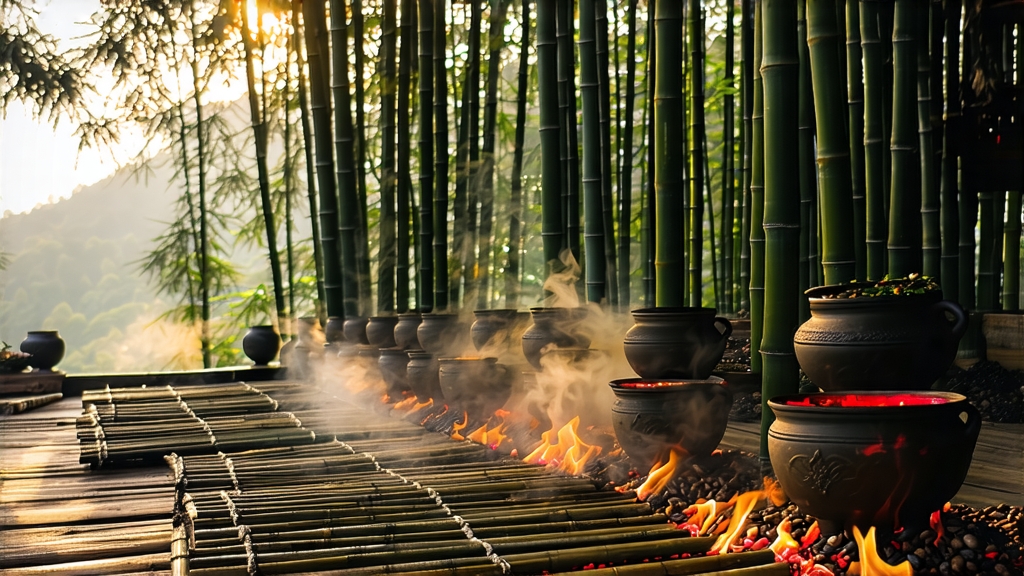
Long before Assam, Ceylon or Earl Grey ever filled European cups, the black-tea story began in a small canyon of China’s Wuyi Mountains with a leaf called Lapsang Souchong. To most Westerners the name evokes a campfire in a cup; to Chinese tea historians it is zhengshan xiaozhong, the “small-leaf kind from the original mountain,” the primordial black tea whose accidental birth in the mid-17th century launched an entire category. This article invites the global tea lover to travel beyond the smoke and discover why Lapsang Souchong remains both a living fossil of tea craft and a contemporary icon of sensory adventure.
-
A leaf born from chaos
Legend places the origin in 1646, when Qing army units passed through Tongmu Village on their march south. Plucking season was at its peak; frightened farmers rushed the fresh leaves to dry over the nearest available fuel—masses of green pine boughs—so that the crop would not spoil before the soldiers left. The resulting tea, heavily scented with resinous smoke, was offered to passing Dutch traders who, against all expectations, loved its assertive aroma and bought the entire lot. Within two decades “bohea” (the Fujianese pronunciation of Wuyi) dominated the docks of Amsterdam and London, and the first global black-tea craze was under way. Recent archival work shows that court records in the Netherlands already mention “the smoked bohea of Singlo” in 1650, giving the legend a plausible calendar. -
Micro-terroirs inside a UNESCO pocket
Tongmu lies inside a granite gorge whose altitude (600–1 200 m), subtropical humidity and year-round fog create a natural greenhouse for the small-leaf tea cultivar Caicha. The surrounding forest of Masson pine and Chinese fir is the indispensable ingredient: only their long needles, rich in turpene oils, can deliver the sweet, resinous smoke that defines authentic Lapsang. Chinese law now restricts the name “zhengshan” (original mountain) to 67 square kilometres inside the Wuyi National Nature Reserve; leaves picked a single kilometre outside may be called “waishan” and sell for one-tenth the price. Thus every sip of true Lapsang Souchong is literally a taste of a protected biosphere. -
Variations under one smoky umbrella
Western supermarkets usually stock a single, rather blunt “Lapsang” that smells like liquid barbeque. In Tongmu itself the family tree is far more nuanced:
- Traditional pine-smoke Zhengshan Xiaozhong: the historical style, withered over pine fires, fired three times, then smoked a final 6–8 hours above embers in a hanging bamboo room. The best grades use only young spring buds (jinxiaozhong) and deliver a surprising balance of honeyed malt and cool pine finish.
- Unsmoked Zhengshan Xiaozhong: created for the modern domestic market that associates smoke with cheap export tea. The same leaves are baked over charcoal made from local oak, yielding a burgundy liquor reminiscent of dried longan and cacao.
- Wild Lapsang: picked from feral bushes seeded by birds at 1 400 m; processed with minimal smoke to highlight notes of camphor and mountain pepper. Production is measured in single-digit kilos per year.
- Crafting the smoke without scorching the soul
The making follows the five classic steps of black tea—withering, rolling, enzymatic oxidation, primary drying, refining—but each is bent toward smoke integration rather than mere oxidation.
Withering is done on bamboo screens set 2 m above pinewood hearths. A gentle fire (45–50 °C) keeps the leaves pliable while they inhale volatiles for 8–10 hours, three times longer than normal black tea. Rolling is still done by foot inside a 1.2 m diameter bamboo drum: the operator’s weight cracks cell walls evenly without heating the leaf mass. Oxidation proceeds in cedar-lined wooden boxes where temperature is raised solely by the leaf’s own respiration; the goal is 80 % oxidation, stopping just before pectins turn the liquor muddy. Primary drying employs the “wolong” technique: leaves are tossed every 30 seconds above a pine-oak mix until moisture falls to 20 %. The final smoking stage is unique